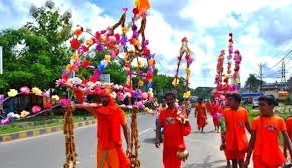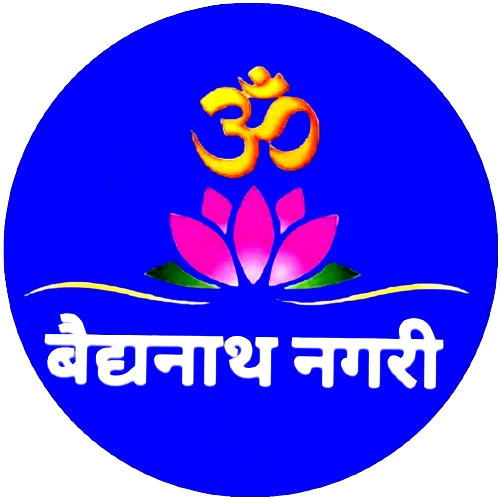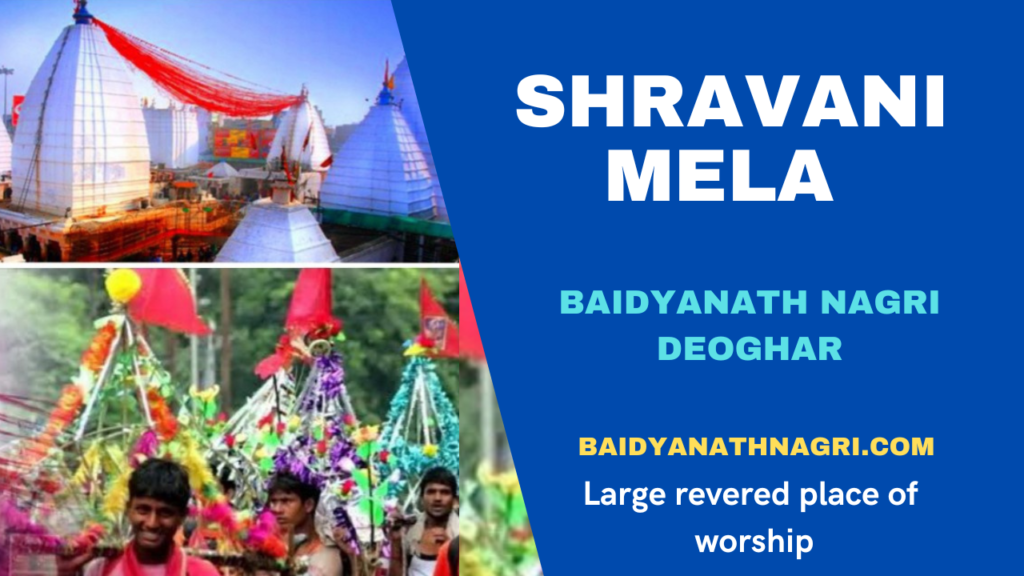- Shravani Mela this year due to Malmas (excess month) Will be conducted in two phases. First Phase Will be held from 4 July to 17 July 2023.
- Malmas will start on 18th July and 16th August 2023 will end and then the second phase of Shravani Mela 17 August to 31 August 2023.
Here is a comprehensive guide to Shravani Mela Deoghar 2023, including key information and related topics:
Also read about: Kanwar Yatra Deoghar
Table of Contents |
|
Shravani Mela Deoghar 2023
Shravani Mela starts in the month of Sawan. In the month of Sawan in Baidyanath Nagri Deoghar, there is a crowd of Shiva devotees, the whole area is covered with Shiva devotees wearing saffron clothes. Devotees of Lord Bholenath come here on their journey to Kanwar by filling water from the Ganges flowing into the Ganges of Sultanganj in Bhagalpur, Bihar.

Devotees of Baba Baidyanath first bathe in the river Ganges at Sultanganj in Bhagalpur and worship at the Baba Ajgaivinath temple and take a vow to complete the holy journey. They take Gangajal from North-Vahini Ganga in two pots and keep it in a Bahangi or Kanwar and carry this Kanwar on their shoulders and come to Baidyanath city Deoghar to offer Ganga water to Baba Baidyanath Jyotirlinga. They walk 105 km. On the way, he recites Bol Bam – Bol Bam. Devotees, who are physically unable to cover this distance on foot, also come directly to Baba Baidyanath temple to perform Jalabhishek by vehicles.

Kanwariyas first enter Shivaganga, and then enter the Baba Baidyanath temple, where Ganga water is offered to the Jyotirlingam. This pilgrimage lasts for 30 days during the entire Shravan month from July to August. It is the longest religious fair in the world.

History of Shravani Mela
Shravani Mela has a history dating back several centuries and is deeply rooted in Hindu mythology and religious beliefs. The festival is associated with the legend of the churning of the celestial ocean, known as Samudra Manthan, mentioned in Hindu scriptures.

According to mythology, during the churning, a pot of poison (halahala) emerged, which had the potential to destroy the world. To save the universe, Lord Shiva drank the poison but did not swallow it. Instead, he held it in his throat, turning his throat blue, earning him the name “Neelkanth” (the one with a blue throat).
The worship of Lord Shiva during the month of Shravan is believed to appease him and seek his blessings for good health, prosperity, and spiritual growth.
- Pilgrimage Route: One of the unique aspects of Shravani Mela is the Kanwar Yatra, where devotees undertake a pilgrimage on foot to fetch holy water from the Ganges River in Sultanganj, Bihar, and carry it back to the Baidyanath Temple in Deoghar.
The traditional Kanwar Yatra route covers a distance of approximately 105 kilometers. Devotees walk barefoot, carrying decorative bamboo structures called “kanwars” on their shoulders.
The route passes through various towns and villages, and devotees often chant hymns and sing devotional songs during the journey. They receive food, water, and blessings from locals along the way. - Devotees and their Practices: Shravani Mela attracts millions of devotees from different parts of India, with a significant number coming from Bihar, Jharkhand, and West Bengal.
Devotees observe various rituals and practices during the festival, including fasting, offering holy water (jalabhishek), and chanting prayers and mantras dedicated to Lord Shiva.
Many devotees dress in saffron or white attire, symbolizing purity and devotion. Some even carry tridents or wear rudraksha beads, which are considered sacred to Lord Shiva.
The atmosphere is filled with devotion, as devotees express their faith and seek blessings from Lord Shiva. They often perform the Rudrabhishek ceremony, where water, milk, and other sacred offerings are poured over the Shiva Lingam. - Cultural and Social Impact: Shravani Mela has a significant cultural and social impact on the region. It boosts the local economy through increased tourism and business opportunities.
The festival also promotes communal harmony and unity, as people from diverse backgrounds come together to celebrate their shared faith.
Various cultural events, music performances, and religious discourses take place during the festival, adding to the festive spirit and providing entertainment to the devotees.
Facilities for Pilgrims in Shravani Mela Deoghar
Free food and medicines are provided to the Kanwariyas round the clock in the camps during the Shravani Mela. Along with the government, private organizations also take an active part in the service of Kanwariyas. Throughout the journey route, you can find several wooden stands at regular intervals where pilgrims can rest their kanwars.

After reaching the Baidyanath Nagari, Deoghar, devotees get into a long waiting queue according to the number of pilgrims available for darshan. The temple management and district administration also provide fast darshanam facility on payment basis. Once the devotees complete the Jalabhishek at Baba Baidyanath Temple, they proceed to perform Jalabhishek at Baba Basukinath Temple which is in Dumka District, about 45 km from Baidyanath Nagari, Deoghar.

Rules for Pilgrims in Shravani Mela Deoghar
There are many rules for pilgrims in the month of Shravan. All the pilgrims coming in the month of Shravan must follow certain rules.
- Vegetarianism
- celibacy
- Truthfull
- Accuracy of speech and thought
- Alcohol and smoking should be avoided.
- Avoid using oils, soaps, shoes and leather items.
- Avoid planting Kanwar on the ground.
| Note : Intoxicants, meat, alcohol and vengeful food are prohibited during the pilgrimage in the month of Shravan. Apart from this, all the devotees wearing kanwar should not touch the kanwar without taking bath during the kanwar yatra and Shravani Mela. |
Precautions for Pilgrims in Shravani Mela Deoghar
- Always beware of pickpockets.
- Do not wear or keep any kind of precious jewelery (gold or diamond etc.) during the journey or in the temple premises.
- Do not believe the rumours at all. Find out the right information.
- In case of theft or conflict, contact the nearest policy station.
- Don’t crowd unnecessarily.
- Maintain a queue while entering the temple hall
- Follow all the instructions given by the officials.
- Stay safe from a stampede by keeping yourself calm.
- Always Carefull
Importance of Baidyanath Nagri Deoghar
Baidyanath Nagri Deoghar is an important Hindu pilgrimage site. It is one of the twelve Jyotirlingas and one of the 51 Shaktipeeths, and is famous for the fair of Shravan, the fourth month according to the Hindu calendar system. It is one of the few places in India where Jyotirlinga and Shaktipeeth are situated next to each other.
Also read about: Shakti Peeth
FAQs on Shravani Mela Deoghar
Q1. When will Shravani Mela Deoghar start in Year 2023?
Ans : This year’s Shravani Mela in Deoghar will start with the beginning of “Saavan” on 4th July 2023. Lakhs of devotees are expected to have darshan.
Note:
- Shravani Mela this year due to Malmas (excess month) Will be conducted in two phases. First Phase Will be held from 4 July to 17 July 2023.
- Malmas will start on 18th July and 16th August 2023 will end and then the second phase of Shravani Mela 17 August to 31 August 2023
Q2. What is the distance from Sultanganj to Baidyanath Nagari Deoghar?
Ans : The distance from Sultanganj (Ajgaivinath) to Baidyanath Nagari Deoghar is about 105 KM.
Q3. How many days Kanwar Yatra Deoghar is completed?
Ans : Common Kanwar Yatris complete the Deoghar Kanwar Yatra in between 3 to 5 days. Dak Bam Shiva devotee completes this journey in one day.


